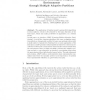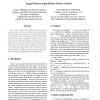30 search results - page 2 / 6 » Segmenting State into Entities and Its Implication for Learn... |
RAS
2006
13 years 4 months ago
2006
This article explores the assumption that a deeper (quantitative) understanding of the information-theoretic implications of sensory-motor coordination can help endow robots not o...
AIIA
2007
Springer
13 years 11 months ago
2007
Springer
The application of Reinforcement Learning (RL) algorithms to learn tasks for robots is often limited by the large dimension of the state space, which may make prohibitive its appli...
AIEDU
2005
13 years 4 months ago
2005
The Bayesian framework offers a number of techniques for inferring an individual's knowledge state from evidence of mastery of concepts or skills. A typical application where ...
ICPR
2000
IEEE
14 years 5 months ago
2000
IEEE
We describe a method for learning statistical models of images using a second-order hidden Markov mesh model. First, an image can be segmented in a way that best matches its stati...
ADVCS
2007
13 years 4 months ago
2007
Cellular learning automata is a combination of learning automata and cellular automata. This model is superior to cellular learning automata because of its ability to learn and als...


